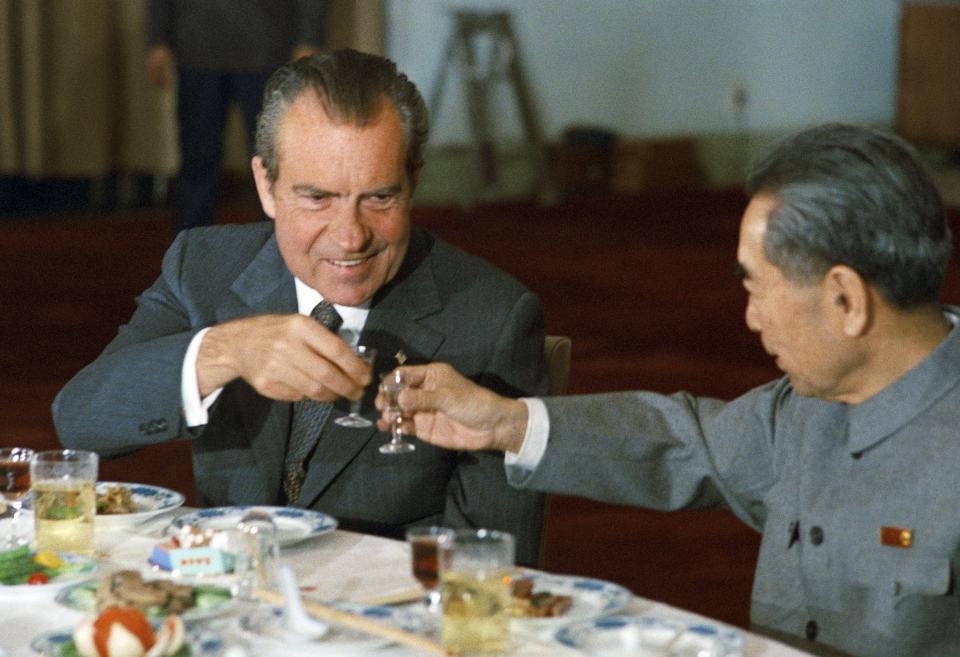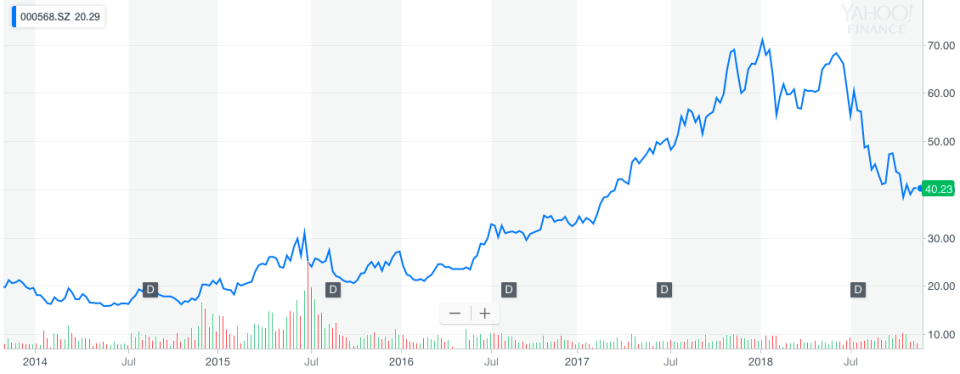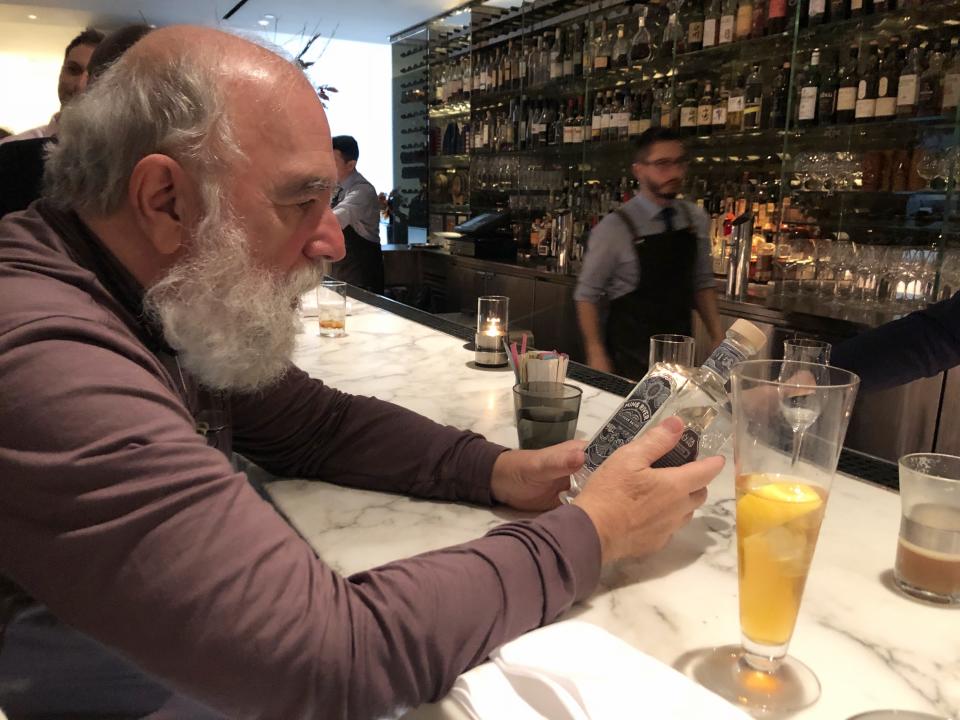The world’s most consumed liquor is trying to conquer the U.S. market
It’s 4:30 p.m.on a chilly weekday in November. Jonathan Brainin, an artist from New Jersey sits alone at a bar inside Modern, a sleek fine-dining restaurant in midtown Manhattan in New York City, trying to kill some time before dinner. He explores the cocktail menu consisting of nearly 20 options. There are hundreds of colorful bottles of liquor used to make the cocktails occupying the wall of the bar.
A drink named Terracotta Navy catches Brainin’s eye. He’s curious about two ingredients in the cocktail — Szechuan peppercorn and baijiu. He still remembers how he almost choked while eating an entree made with peppercorns at a Szechuan restaurant. And he never heard of baijiu, the base of the drink.
Brainin just wanted to know what baijiu is. He asks a bartender, who pulls out a glass bottle of Ming River baijiu from the shelf, and opens the lid to let Brainin smell it. A strong aroma emerges from the bottle, something he has never smelt before. Five minutes later, his glass of Terracotta Navy arrives in an opaque and yellow color.
“This is floral and fruity. It’s very different than anything I’ve had before,” Brainin said. “But it’s not a girly drink.”
Invented in China, baijiu (pronounced “by-joe”) is now the most consumed liquor in the world and is poised to record the largest growth among all spirits categories over the next five years, according to the International Wine & Spirits Group. Baijiu literally means “white liquor” in Chinese and has become the go-to drink for gatherings and celebrations in China, from family dinner tables to high-profile diplomatic banquets. But it’s only recently been discovered here in the U.S.
‘China’s vodka’ isn’t popular in the U.S.

Selling China’s national liquor to Westerners isn’t as easy as selling Chinese food. Baijiu represents less than 1% of liquor sold in the U.S., according to the U.S. Distillery Council. Sometimes referred to as China’s vodka, the clear spirit may even deter some vodka lovers. It usually contains 40%-65% alcohol by volume and brings a throat-burning experience.
Patrick Smith, the bar manager at the Modern, still recalls the first time he tried baijiu. “It’s wired to say the least,” Smith said. “But that’s OK. Weird tasting things can also be delicious.”
Bringing baijiu to his bar was an easy decision. He was approached by William Isler, the CEO of Ming River earlier this year. “I want to bring liquor from all over the world to people coming to the bar, and having the most popular one missing has been a pity,” Smith said.
The hard part is to mix it in a way that average drinkers can appreciate it. It took Smith a few weeks to develop the cocktail. Baijiu is the “bully” in the drink, because it’s so intense and strong, that Smith has to use lemon to add some fruitiness to it. A chef at the restaurant suggested he put in salt to remove the savory taste in the drink, since it’s made from fermented sorghum.
At $20 a glass, the baijiu-based cocktail has emerged as the top five drinks at the bar, which Smith feels proud about. “Any time I encounter someone who hasn’t had it before, that’s an opportunity for me to blow their mind, because it’s such an interesting flavor.”
In China, there’s no such thing as baijiu cocktails

Isler describes his baijiu brand’s flavor as “a mix of tropical fruit, pepper, and then yeast, and then a slight cheesy funkiness to it.” He emphasizes baijiu has many variants and different types of baijiu can be as different as whiskey is to rum. The one his startup is trying to introduce is specifically developed for the U.S. market. It comes from the classic Szechuan-style, which has a strong aroma and is the best-selling style in China.
Brainin’s way of drinking baijiu in New York City couldn’t be more different from how Chinese consume it. There’s baijiu everywhere in China, except in bars. In China, baijiu is not sold by the glass, either. People drink it over the dinner table, often with intricate etiquette. Whether it’s in restaurants or stores, baijiu is sold in whole bottles.
When Isler was living in Beijing, he saw the opportunity to provide non-Chinese people with a place where they can come and learn about and sample baijiu. In 2014, he gained media attention when he opened Capital Spirits, the world’s first baijiu bar in Beijing.
“All we did is we did something that no Chinese person thought to do, which is just to treat baijiu the same way as you treat any Western liquor,” Isler said.
The results of the experiment are encouraging. The bar, inside a hutong, has attracted not only expats, but also young Chinese, especially women, who usually think drinking baijiu is old-fashioned.

Isler’s success came at the very worst time for the baijiu industry in China. Baijiu companies’ sales slumped after China’s President Xi Jinping came into power in 2014. Xi launched an anti-corruption campaign, cracked down on government officials using public funds to consume baijiu and who received expensive bottles of baijiu from business people as gifts.
Having proved he can sell baijiu to foreigners, Isler was approached by several local distilleries which were looking for new revenue streams. He ended up working with Luzhou Laojiao, one of the oldest distilleries in Szechuan, a $8.5 billion giant who offered Isler and his partners an initial $6 million all-cash investment.
Isler appreciates the flexibility he was given, even though Luzhou Laojiao is a state-owned enterprise. “They understood that it wouldn’t be profitable right away — that we could expect to lose money for the first three years,” Isler said.
One bar at a time

Since June, Ming River has been targeting three major metropolitan areas in the U.S. — New York, Los Angeles, and San Francisco. In Isler’s eyes, there are two types of clients, one is Chinese restaurants who would inherently have interest in the alcohol. The other are bars and restaurants like the Modern, which cater to mainstream American drinkers who are always looking and willing to try new and interesting cocktails.
“They want to be innovative and unique. They want to set themselves apart. We provide a tool with which they can do that,” Isler said.
Still, it takes some time to introduce his brand and educate Westerners about baijiu, which is more than thousands of years old. For now, Isler’s approach is to conquer one bar at a time. When he and partners “canvass” in bars across cities to make sales pitches, they bring not only Ming River but other styles of baijiu, so that bartenders can taste the difference between baijiu.
That’s how Smith, who brought baijiu to the Modern’s cocktail menu four months ago, got hooked. “The best way to learn about the taste is to try it,” Smith said. That’s the message he is sharing with customers, too.
After finishing his baijiu cocktail, Brainin asks the bartender to give him a shot of Ming River, the baijiu base of the drink, which has a 45% alcohol level. He takes a sip. “Wow, this is so much stronger than the cocktail,” he said. “I prefer the cocktail.”
Krystal Hu covers technology and trade for Yahoo Finance. Follow her on Twitter.
Read more:
Black Friday will be big, but analysts don’t really care
Why you won’t feel much pain from Trump’s tariffs this holiday season
We entered the multimillion-dollar business behind your Amazon returns


